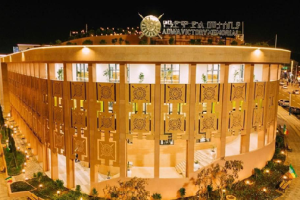
BY MULUGETA GUDETA
Addis Ababa is a city of contrasts between the new and the old, between the haves and haves not, and between the past and the present. These contrasts have evolved over more than 125 years of the city’s existence as the capital of a rising empire. The empire ended in 1974 but the city and its contrasts continued to grow. Under the first and second republics (i.e.Under the Derg and EPRDF), the old Addis continued to survive side by side with the new Addis. The Addis of shanty towns and the city of high rises, dominated by the new headquarters of the Commercial Bank of Ethiopia have drastically changed the city’s skylines. This is the new face of Addis Ababa in the 21st century.
Addis Ababa is undergoing tremendous changes as we peen these lines. The change can perhaps be geographically or topographically delimited. The northern part of the “New Flower” is changing beyond recognition. Starting from the Entoto hills, change is flowing down to the city’s epicenter. Three years ago, there was not much to be said about Entoto, except that it was a collection of hills dominating the capital and filled with old eucalyptus forests, barren spaces where footpaths meander down the hills.
Wood carrying women bent under the weight of the burden they carried were the ubiquitous sights in that otherwise desolate place. The area was also frequented by patients who went to the famous Entoto Mariam holy water in search of cures for various ailments. Apart from that, the place was the darling of long-distance runners who used Entoto’s high altitude for training.
The women who carried the woods on their backs sold them to the inhabitants of the surrounding areas as firewood for cooking meals. These women were mostly middle-aged, malnourished, and as thin and dry as the woods they carried. They did not make much from the firewood, only that they could garner the smallest energy needed to carry more woods in order to make ends meet in their daily struggle for survival.
Nowadays, Entoto Hills may not be as sumptuous as Beverly Hills, but they seem to be going in that direction. A state-of-the art park and recreational and sports center bring to mind a kind of Disneyland attraction. Standing on the edge of the vast collection of many recreational facilities, you can see the centre of Addis in the distance, with its high rises pointing towards the sky and glistening in sunlight as well as its shanty towns covered with fog and mist, exposing their rusty corrugated tin covers to the sky as if they are appealing to God for mercy and for a chance for a new life.
Addis, the city of contrasts, is expanding vertically as well as horizontally. The condominium housing states are spreading in all directions, giving the impression that they are mini-cities within the big city. A new and more recent addition is the new face of Meskel Square which was first built by the Derg regime as an Ethiopian version of Moscow’s Red Cross in those revolutionary days. Most students who were radical firebrands opposed the construction of the square as an attempt by the military government to extend its rule. If those same students saw what has become of Meskel square, they would certainly have a second thought, a more positive one, this time around.
What the Derg regime had done is to rename Meskel square by calling it Revolution square. For many decades, the square served as a meeting place for the Meskel celebrations around the huge bonfire that was burning and around which congregated the followers of the Ethiopian orthodox Church. The occasion was attended by the emperor and his retinue of aristocrats and various dignitaries. There were songs and dances, religious as well as secular that lasted into the night. The place was not remarkable as it is now and there were a few eucalyptus trees standing on one side and the terrain became swampy when it rained. Now the square has changed beyond recognition.
As indicated above, the place was renovated and renamed in the 1970s. If there any change during the 27 or so years of EPRDF rule, the square continued to serve both as a place of protest and sports. Hundreds of young and old people used the square for morning jogging and training ground. Besides that the place was also the sight of political rallies. The 2005 pre-election rallies both by government supports and opponents can be taken as an unforgettable political milestone in the history of the square which was then changed from Revolution Square back to Meskel Square.
As it could be expected in those turbulent times, Revolution Square turned out to be the epicenter of the Ethiopian revolution where the major class battles were fought between the regime and youngsters who opposed it. Major national and international anniversaries were celebrated at the square. Demonstrations in support or in opposition to the government took place at the square. Mammoth rallies took place there. There were also episodes of violent clashes between supporters and opponents of the then ruling party and the radical parties. Notable is the 1976 May Day demonstrations at the square that turned bloody and ushered in a new era of bloodshed. Ironically the memorial for the victims of that and other acts of violence during the Red Terror, is now located a stone throw from the square.
Fast forward to 2021 and you have again a new Meskel Square, this time a state-of -the art construction, reminiscent of similar places in developed cities. This is a project that has deeply changed the face of the new Addis as it is surrounded with equally attractive parks and green areas in Addition to an underground parking lot for more than one thousands cars. This is in fact the revolutionary change that has taken place at Meskel square. From there to the Italian-era Piazza, the road along Churchill Road give the impression that a new street has come into being.
You feel less constrained by the former narrow street as you have more room or space for free movement as you walk along Churchill Road. You walk on tiles and that adds more sense of cleanness or neatness to your journey. The wooden benches on the other side of Teodros Square, along the newly expanded street gives the impression that you are somewhere in Europe or America where people not only site on the benches but also read books and newspapers or gaze at the scene around as a means of relaxation or by way of entertainment.
When you reach the top of the escarpment, you meet a renovated space where the legendary Gashe Abera Molla had started to do the same thing during his cleaning campaign back in the 1990s. This place should be named after him by way of remembering all those who have contributed to the beautification and cleanliness of the capital and as an inspiration for future activists.
Addis Ababa is undergoing more than a cosmetic uplift. It is being restructured and redesigned. It is adding new parks and high rises like the collection of high rise buildings that serve as the financial centre of the ever growing metropolis. Addis is increasingly looking at the sky both figuratively and symbolically. However, it seems that it has forgotten to get rid of one of its curses from the past, namely its defective drainage system that inundate the streets and squares with rainwater as soon as winter makes its presence felt.
Addis is being rebuilt from the ground up while it is lacking an efficient underground sewerage system like all international cities worthy of the accolade. Those spacious streets are bound to be flooded with rainwater and cause mishaps to pedestrians while creating car accidents and flooding along river banks like the one near the Ethio-telecom headquarters burst and caused mayhem a decade or so ago. A sewerage system can be taken like the belly of a city and if the belly is not healthy and clean it would be hard for the city to maintain its newfound and appearance for long.
The next phase of the beautification of the Ethiopia might take into consideration the many homeless people who are using the streets and squares as night shelters. There is a need to resettle these people somewhere in the city in a temporary or permanent shelter for the homeless and jobless. This can also be done if the investors in the capital make up their minds to raise funds for this purpose as their largesse is behind the ongoing facelift in the capital. It would be humiliating to have such a beautiful city in the making and a large number of its underprivileged citizens having nowhere to go when it is cold or rain at night. The beauty of a city should also take into consideration its human element that has so far remained the soft belly of a capital booming and brimming with activities.
THE ETHIOPIAN HERALD JUNE 23/2021





